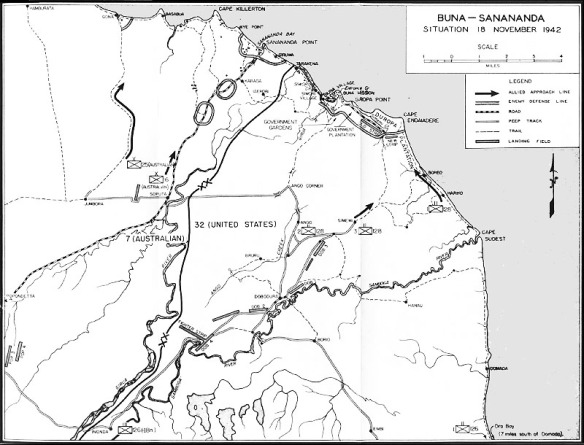MacArthur, lacking personal knowledge of conditions at Buna, ordered Harding to attack again and take Buna at once “regardless of cost.” Given back a battalion of the 126th Infantry, Harding launched the attack on November 23. Units from the 126th Infantry got within 300 yards of Buna Village, but the 128th Infantry got nowhere. Short of supplies and with little to show for his efforts, Harding now became reluctant to order more assaults unless they had a good chance of success. Instead, he asked MacArthur for howitzers, tanks, and the division’s third infantry regiment, the 127th Infantry. Under renewed pressure from MacArthur, Harding sent his forces forward in another attack on November 30; however, it was easily repulsed.
Even before the failure of Harding’ latest attack, MacArthur had become agitated by the lack of progress at Buna. Australians, to his embarrassment, were making disparaging remarks about the morale and discipline of the 32d Division, and his difficulties in New Guinea contrasted sharply with the recent U.S. triumphs at Guadalcanal. At the end of November, MacArthur sent staff officers to look into the situation at Buna. They did not go to the front to see first-hand the conditions the troops faced and saw instead only the wounded, demoralized, and frustrated men in the rear, which led them to report that the officers of the 32d Division were unaggressive and that the men lacked the will to fight. Major General Richard K. Sutherland, MacArthur’ chief of staff, advised Harding to make changes in the division’s leadership, but Harding refused, apparently ready to take the heat for his subordinates.
The reports of his staff convinced MacArthur that the trouble at Buna was not the strength of the Japanese position and the 32d Division’ need for proper weapons and reinforcements but Harding’s leadership. As a result, on November 30 he sent Lieutenant General Robert Eichelberger, commander of the I Corps, to Buna, telling him, “Take Buna or don’t come back alive.” Arriving at Buna on December 1, Eichelberger, after a quick tour of the front, judged that the division was awash in inertia and combat avoidance. Following a bitter exchange with Harding over the division’s leadership, Eichelberger relieved him, fired most of his regimental- and battalion-level officers, and made plans for a new attack.
In Eichelberger, MacArthur had a hard-nosed leader who understood that he was to “do something” and not be overly concerned about the “butcher’s bill”—one of Harding’s principal failings in MacArthur’s eyes. Initially, however, when Eichelberger launched his own offensive on December 5, he had no more success than had Harding. But after a week of bloody fighting, a platoon from the 126th Infantry reached the sea, driving a wedge between Buna village and the mission, and on December 14 Americans overran the village. The Australians, meanwhile, captured Gona village on December 9.
Eichelberger’s battlefield success was matched by an improving supply and manpower situation. Food supplies were now arriving in sufficient quantities, greatly boosting morale, and the tanks that Harding had requested also began to arrive. At the same time, there was an injection of fresh troops, including the 127th Infantry and two Australian infantry battalions, to reinforce the depleted 128th Infantry.
On December 18 Eichelberger launched another attack. Using tanks to envelop the Japanese bunkers and aided by the growing weariness and hunger of the defenders, U.S. and Australian infantry on the Warren front gradually pushed the Japanese back and seized Duropa Plantation. On the Urbana front, where the terrain could not support tanks, the infantry advanced slowly, fighting from tree to tree and bunker to bunker. Finally, the two forces linked up on December 28, and between December 31 and January 2, 1943, they flushed out the last Japanese from Buna mission and the surrounding jungle. Fighting concluded on January 22, when Australian and U.S. units—augmented by a recently arrived regiment from the 41st Division—wiped out the last Japanese pocket at Sanananda. The elimination of the Buna-Gona stronghold ended the Papua campaign. During its five months the Japanese lost nearly 12,000 men. The Australians had 2,000 dead and wounded, and the 32d Division had 690 dead and 1,700 wounded. Another 2,900 men from the 32d Division were hospitalized suffering from tropical diseases. For the Allies the campaign was a significant victory. MacArthur now had airfields from which Kenney could cover future offensives, and the Americans had learned much about jungle combat and Japanese tactics that served them in good stead. Also, the campaign greatly influenced MacArthur’s thinking. Mortified by the heavy Allied casualties, he concluded that similar battles should be avoided in the future. Thereafter, with “No more Bunas” as his watchword, he would try to avoid well-defended Japanese strongpoints and let them wither on the vine as he fought his way toward the Philippine Islands.
FURTHER READINGS Anders, Leslie. Gentle Knight: The Life and Times of Major General Edwin Forrest Harding (1985). Chwialkowski, Paul. In Caesar’s Shadow (1993). Doherty, Tom. “Buna: The Red Arrow Division’s Heart of Darkness.” Wisconsin Magazine of History (1993–1994). James, D.Clayton. The Years of MacArthur, vol. 2 (1975). Luvaas, Jay. “Buna, 19 November 1942–2 January 1943: A Leavenworth Nightmare.” America’s First Battles, 1776–1965, ed. Charles E.Eller and William A.Stofft (1986). Mayo, Linda. Bloody Buna (1974). Milner, Samuel. Victory in Papua (1957). John Kennedy Ohl
